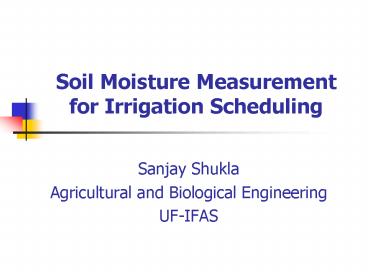Soil Moisture Measurement for Irrigation Scheduling
1 / 20
Title:
Soil Moisture Measurement for Irrigation Scheduling
Description:
Tensiometer. Tensiometers. Water potential ... More costly than tensiometer and resistance types. Capacitance Probe. Capacitance probe ... –
Number of Views:2884
Avg rating:3.0/5.0
Title: Soil Moisture Measurement for Irrigation Scheduling
1
Soil Moisture Measurement for Irrigation
Scheduling
- Sanjay Shukla
- Agricultural and Biological Engineering
- UF-IFAS
2
Irrigation Scheduling
- Appropriate water at appropriate time
- Crop need, soil properties, and weather condition
- Different methods
- Experience
- Calendar method (0.8 in every 4th day)
- Soil water measurement based irrigation
- Dynamic water balance water budget
3
Soil Moisture Measurement
- Direct method
- Gravimetric method
- Indirect
- Tensiometric (energy status related to
moisture) - Tensiometers
- Resistance blocks
- Psycrometer
- Volumetric
- Nuclear method (Neutron probe)
- Dielectric methods
- Time Domain Reflectometry (TDR)
- Frequency Domain Reflectometry (FDR)
- Capacitance, TDT, ADR, Phase Transmission
- Other
After EDIS Bul. AE266
4
Types of Devices
- Fixed
- measurements at a fixed location
- depths
- single (e.g. 8 in.)
- multiple (e.g. 4, 8, 12 in.)
- Portable
- fixed location access pipes with portable reader
- Hand held
- can measure moisture anywhere at farm/grove
5
BREAK / DEMO
6
Tensiometer
- Tensiometers
- Water potential
- Need to related tension to volumetric water
content to know available water - Soil water characteristics curve (Put a figure
for a variety of soils) - Advantages
- Relatively inexpensive (100) and easy to use
- Limitations
- Slow response, needs maintenance, manual reading,
lack of contact in sandy soils
7
Electrical Resistance
- Porous Blocks to measure electrical resistance as
a function of water content - Advantages
- Low cost and maintenance
- Ease of use
- Limitations
- Delayed response in sandy soils
- Dry conditions - reinstallation
- Errors in soils with high salinity
8
Dielectric Method
- Based on mediums capacity (dielectric constant)
to transmit high frequency electromagnetic
wave/frequency - D Const 1 for air, 2-5 for soil, and 80 for
water - Two approaches
- Time Domain Reflectrometry (TDR)
- Frequency Domain Reflectometry (FDR)
- Better devices than other types
- More costly than tensiometer and resistance types
9
Capacitance Probe
- Capacitance probe
- Dielectric properties of soil
- Modern probes can log data for every 5 minute and
higher - Single and multiple depth probes
- Manual measurements to continuous logging
- Manual Diviner, Echo Probe
- Automatic Enviroscan, EasyAG, C Probe
- Accurate measurement
- Data can be stored for 2-4 weeks and downloaded
to computer
10
Examples of Types of Devices
11
Capacitance Probe
12
Portable Capacitance Probe
Cost 2000
13
TDR Probes
- Estimate the dielectric constant by the travel
time for electromagnetic wave to go through a
transmission line (parallel rods) - Measure average soil moisture content along the
waveguide (soil cylinder of approx 1.5 times the
spacing) - Better accuracy
- Types of devices
- Portable e.g. Hydrosense (600)
- Automatic e.g. CS 616 (Campbell Sci.)
- Can be used to measure moisture at multiple
depths
14
TDR Probes
Cost 600
15
Use of Soil Moisture Measurement Devices
- Know your soils and crop root zone
- Contact USDA-NRCS or refer to county soils map to
get the field capacity and wilting point - Manage the soil moisture in the root zone between
the field capacity and 50 of the plan available
water (management allowable deficit (MAD) PAW
FC PWP) - example
- field capacity 12 wilting point 6, PAW 6
- point for turning the irrigation on 9
16
Capacitance Probe Multiple sensors (4, 8,
12, and 20 in)
Irrigation
Stop - water below root zone
17
Selection of Devices
- Factors for selection
- Size and management of the farm
- Soil-hydrologic factors
- How closely you want to fine tune irrigation
- Cost limitations
- 200 to 17,00
- Personnel available
- Be aware of the sensor accuracy
- Especially for sandy soils (FC 9 WP 4, PAW
5) - If possible, use multiple depth probes
- Using factory calibration does not always mean
accurate results - Most of the available probes are suitable for
basic scheduling decisions
18
Location of Soil Moisture Measurement
- Factors for selecting locations
- Soil series map (soil spatial variability)
- Known wet and dry areas
- Type of irrigation
- More the better
- Multiple soils within the irrigation zone
- Example 50 acre zone
- 49 acre, high WHC 2 acre, low WHC
- Soil moisture from 49 acre for managing
irrigation - 30 acre with high WHC and 20 acre with relatively
low WHC - Install multiple probes or use the moisture from
20 acre
19
Location of Soil Moisture Measurement
- Example
- Multiple sensor probes (cost and soil dependent)
- Fruit crops (orchards) Citrus - 10 probes for
1000 acres - Row crops Vegetable - 5 probes for 500 acres
- Manual/Portable
- Take measurements from different soil (and crop
types) - With experience, can do good irrigation
scheduling - Type of irrigation
- Install the probe within wetted area of the
drip/microsprinkler
20
Use of Telemetry
- Wireless transmission of data from field to
office - Requires less time (travel and personnel)
- Current data can be available on the internet
anywhere, anytime - Enviroscan Wireless logger
- C-Probe
- Lease the system
- Yearly contract































